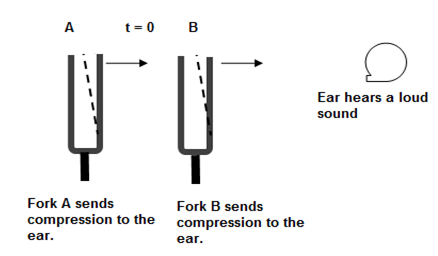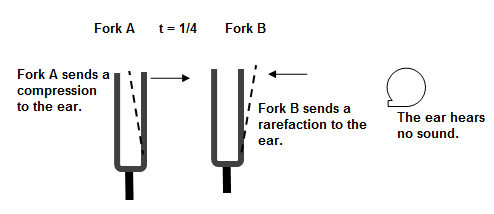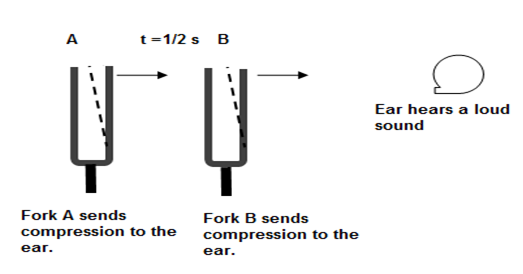Question 8: What are beats? How they are produced and show that the number of beats per second is equal to the difference of frequencies of the two sources.
ANSWER
The periodic variation in the loudness of sound which is heard when the two notes of nearly same frequencies are simultaneously played are called beats.
It should be noted that;
- One maximum and one minimum loudness form a beat.
- Beats are produced when two sound frequencies are slightly different from one another.
- For beats to be heard clearly, the difference between frequencies should be small.
Production of beats
In order to observe the phenomena of beats, consider two tuning forks of slightly different frequencies. Schematically, let the frequency of one tuning fork is 256 Hz and that of other is 254 Hz. Both forks are placed at same distance from the ear. Now, both forks are sounded simultaneously. We observe that;

(1) At time t = 0, both forks are sending compression’s toward the ear. They reinforce each other and a loud sound is heard.
(2) At time t = 1/4 seconds, one tuning fork has completed 256 x 1/4 = 64 vibrations and ready to send the compression of 65th vibration. But at the same time (i-e, t = 1/4 sec) the other tuning fork has completed 254 x 1/4 = 63.5 vibrations. This means that 63 vibrations completed and the 64th is half completed and it is now sending the rarefaction of 64th vibration.
The compression from tuning fork A and rarefaction from tuning fork B will cancel each other as they reach the ear. Therefore, no sound will be heard.

(3) After t = 1/2 seconds, fork A would have completed 256 x 1/2 = 128 vibrations and will be sending compression of 129th vibration to the ear.
At the same time (t = 1/2 sec) fork B would have completed 254 x 1/2 = 127 vibrations and will be sending the compression of 128th vibration to the ear.
Both the compression’s will reinforce one another and a loud sound will be heard.

After t = 3/4 second, fork A would have completed 256 x 3/4 =192 vibrations and will be sending the compression of 193rd vibration to the ear. After the same interval of time, fork B would have completed 254 x 3/4 = 190.5 vibrations and will be sending the rarefaction of 191st vibration to the ear. The sounds from both forks cancel one another and no sound is heard.

At t = 1 sec, fork A has completed 256 vibrations and will be sending the compression (of 257th). At the same time, fork B would have completed 254 vibrations and will be sending the compression of 255th vibration. Both the vibrations will reinforce and the ear will hear a loud sound again.
There is one second of time and two beats are produced. The difference in frequencies is also 2. Therefore, we conclude that the number of beats per second is equal to the difference in the frequencies of the two waves.

Beat frequency (in case asked)
Beat frequency is defined as the difference between the frequencies of two waves creating the beats.
Suppose,
- The time interval between two successive sound waves is t1 – t2 = T.
- f1 is the frequency of first wave.
- f2 is the frequency of second wave.
In time interval T, the number of oscillations of first wave is f1T and that of second wave is f2T.The difference in oscillations is f1T – f2T.
Let the difference in oscillation is 1. Then,
f1T – f2T = 1
(f1 – f2) T = 1 ⇒f1 – f2 = 1/T
But f1 – f2 = N (Number of beats)
Therefore, N = 1/T
If ‘f’ is the beat frequency, then,
f = 1/T
Where f is the beat frequency and T is its period.
Uses of beats
- Beats are used in finding an unknown frequency. If there are two sources of sound sending waves with frequencies f1 and f2. If f1 is known and f2 is unknown. Observing the beats produced by them we can find f2 using N = f1 – f2.
- Beats are used for tuning the music instruments. Tuning music instrument is in fact, adjusting one sound to match or relate to the second sound of other musical instrument.

Pingback:Comprehensive Questions on Waves … msa – msa
Pingback:doppler-effect – msa
Pingback:speed-of-sound-and-temperature – msa
Pingback:index-cqs8-p11